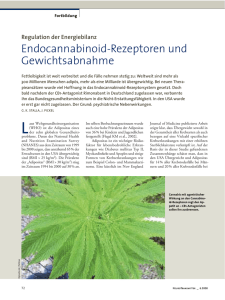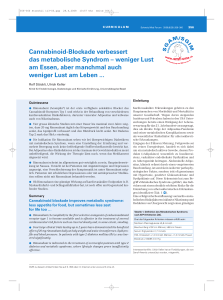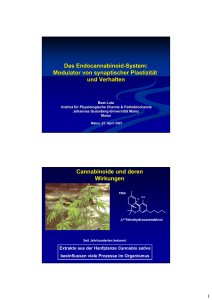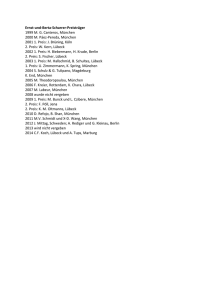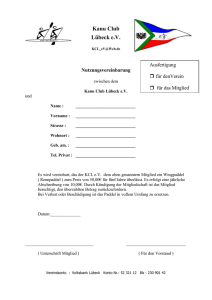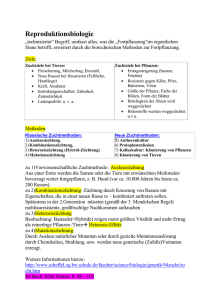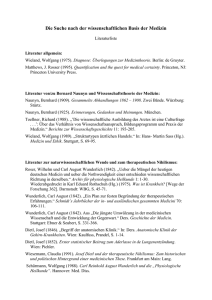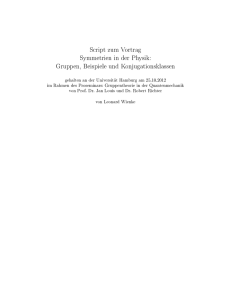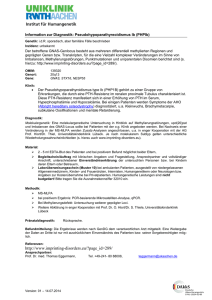Therapeutic Options - adipo
Werbung
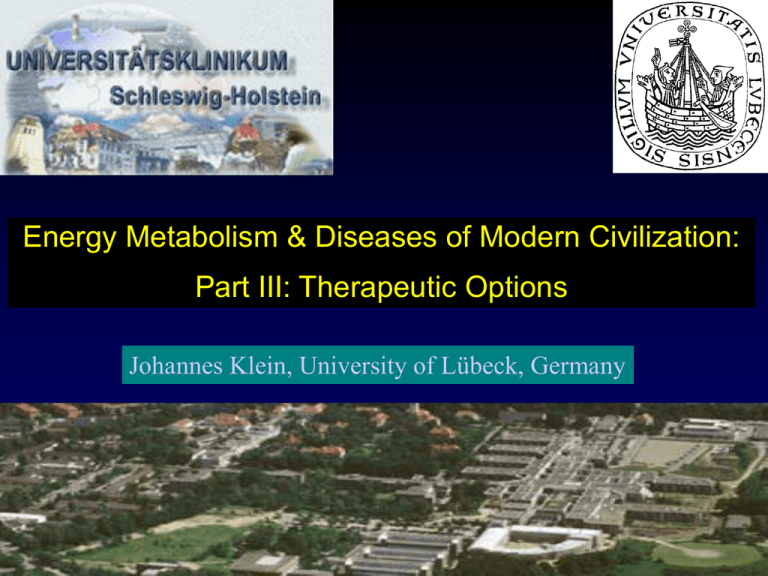
Energy Metabolism & Diseases of Modern Civilization:
Part III: Therapeutic Options
Johannes Klein, University of Lübeck, Germany
Adipocyte Biology
Adipocyte-Based Therapies
Alteration of Insulin/EC/GIP Signalling
b3-Adrenoceptor Agonists/TZD/CNTF
Conversion of WAT to BAT
Leptin/Adiponectin/Visfatin Analoga
11b-HSD-1 Inhibitors
PAI-1/RAS/Adipotensin Blockers
RBP4 Urinary Excretion Enhancer
Klein 2006
Trends in Endocrinology and Metabolism
Farooqi et al., N Engl J Med, 1999
Mean ({+/-}SE) Plasma Glucose Levels in Response to an Insulin-Tolerance Test (Panel A) and an
Oral Glucose-Tolerance Test (Panel B) in Nine Patients at Base Line and after Four Months of
Leptin-Replacement Therapy
Oral, E. A. et al. N Engl J Med 2002;346:570-578
Clinical Course of Patient 1, as Assessed by Changes in Mean Triglyceride Levels, Glycosylated
Hemoglobin Values, and Serum Leptin Values
Oral, E. A. et al. N Engl J Med 2002;346:570-578
Follicular, Ovarian, and Endometrial Ultrasonographic Measurements at the Beginning and End
of the One-Month Baseline Period and at Their Maximum during r-metHuLeptin Treatment
Welt, C. K. et al. N Engl J Med 2004;351:987-997
Representative Patterns of LH Pulsatile Characteristics at Baseline and after Two Weeks of rmetHuLeptin Therapy in Eight Subjects
Welt, C. K. et al. N Engl J Med 2004;351:987-997
Individual Protection
Against Environment:
Preservation of Species:
Fit for Fight & Flight:
Reproduction:
Immune System
Endocrine System
Survival
Energy storage & release:
Energy management
Klein, Discovery Medicine 2006
Fit for Fight & Flight
Immune
Function
Reproduction
Endocrine
Function
Adipose Tissue
Energy Management
Energy storage & release
Klein, Discovery Medicine 2006
Mögliche Ursachen einer Dysregulation des Energiestoffwechsels
I) „Afferenz“ gestört:
- veränderte Regulation der Energieaufnahme/-verwertung
Mögliche Ursachen:
- genetisch: Leptin-Mangel, Melanokortin-Rezeptor-Mutationen (MC4), Ghrelin?
- Umwelt:
- Medikamente: Cortison, Cannabis
- Lifestyle bei kumulativem Effekt von „Meßfehlern“
(Insuffizienz des Systems, Regelschwankungen zu korrigieren)
II) „Efferenz“ gestört:
- Effektormechanismen der Energieabgabe gestört
Mögliche Ursachen:
- genetisch: b3-Adrenozeptor-, UCP-1-Mutationen
- Umwelt:
- Medikamente: beta-Blocker
- Lifestyle bei inadäquater „Sympathikus-Adaptation“
Adipositas: Therapieansätze
Adipositas: Therapieansätze
• Diät: Low Calorie Diet, Very Low Calorie Diet, Lower-Fat Diets
• Bewegung
• Verhaltenstherapie
• Bariatrische Chirurgie (u. a. gastric banding, Y-Roux-Anastomose, Gastroplastie)
• Pharmakotherapie
•„priming“ in utero?
Equation of Energy Homeostasis
Food Influx = Energy Efflux
Environment
Genes
Fat
Fat
Mögliche Ursachen einer Dysregulation des Energiestoffwechsels
I) „Afferenz“ gestört:
- veränderte Energieaufnahme/-verwertung
Mögliche Ursachen:
- genetisch: Leptin-Mangel, Melanokortin-Rezeptor-Mutationen (MC4), Ghrelin?
- Umwelt:
- Medikamente: Cortison, Cannabis
- Lifestyle bei kumulativem Effekt von „Meßfehlern“
(Insuffizienz des Systems, Regelschwankungen zu korrigieren)
II) „Efferenz“ gestört:
- Effektormechanismen der Energieabgabe gestört
Mögliche Ursachen:
- genetisch: b3-Adrenozeptor-, UCP-1-Mutationen
- Umwelt:
- Medikamente: beta-Blocker
- Lifestyle bei inadäquater „Sympathikus-Adaptation“
Medikamentöse Adipositastherapie
I Afferenz:
Orlistat (Resorptionshemmer)
Phentermin
II Efferenz:
b3-Adrenozeptor-Agonisten
Schilddrüsenhormon T3
III Afferenz u. Efferenz:
Sibutramin
Cannabis-Rezeptor-Antagonist
Leptin
Ciliary Neurotrophic Factor (CNTF)
Inkretine?
The slim obesity market
An appetizing choice to the slim market?
UNIVERSITY HOSPITAL
Schleswig-Holstein, Lübeck
Das Endocannabinoid-System:
Von der Unterkühlung der Maus zum Hot Topic beim Menschen
Johannes Klein
Department of Internal Medicine I
UNIVERSITY HOSPITAL
Schleswig-Holstein, Lübeck
Molekulare Angriffspunkte und Wirkmechanismen
Der Endocannabinoide
Johannes Klein
Department of Internal Medicine I
Das Endocannabinoid-System
1964
– Chemische Identifizierung von THC
1990
– Klonierung des CB1-Rezeptors
UNIVERSITY HOSPITAL
Schleswig-Holstein, Lübeck
Vorkommen von “Endocannabinoid”-Rezeptoren
CB1
• Gebiete im Gehirn, die für
Regelung des Energiehaushaltes bedeutsam
sind (z. B. Appetit)
• Nervensystem d. Darmes
• Fettzellen
• Leberzellen
Johannes Klein
Department of Internal Medicine I
Cannabinoid-Rezeptoren,
Endocannabinoide
1
1990: CB1-Rezeptor
1993: CB2-Rezeptor
1
M
L
L
7-TransmembranRezeptoren
CB1
E
CB2
O
1992
N
H
Anandamid
OH
1995
360
472
OH
O
O
Lipide
OH
2-Arachidonoyl-Glycerin
Eigenschaften der Endocannabinoide:
Biochemie
• sind Lipide
(Arachidonsäure-Abkömmlinge, ähnlich Prostaglandinen)
• werden « bei Bedarf » (nach Stimulation) synthetisiert
(werden nicht in Vesikeln aufbewahrt !)
(daneben auch konstitutive Produktion möglich)
• werden schnell wieder abgebaut (durch Enzyme)
Aktivierung von CB1-Rezeptoren
Cannabinoide
CB1
Gi/o
-
Adenylatcyclase
↓ cAMP
↑ Kaliumkanäle
+
K+
-
Ca2+
↓ Kalziumkanäle
► Verminderung der Erregbarkeit der Neuronen
B
A
0 (h)
120
4
100
mRNA Levels
100
Control
60
**
80
(% of Basal)
**
60
CB Agonist
40
20
Terminal
Differentiation
0
Basal
100nM
1µM
Perwitz N, Klein J, Horm Metab Res, 2006
Cb1-Receptor agonists induce hypothermia in rodents and primates
Rawls et al. 2002, Compton et al. 1992, Fan et al. 1994, Spina et al. 1998, Fox et al. 2001
Das Endocannabinoid-System ist ein vielseitiges Signalsystem im Körper
aktiviert um ...
zu entspannen
Reduktion von Schmerz. Reduktion der Körpertemperatur
zu ruhen
Reduktion der Bewegungsaktivität
zu habituieren
Modulation der Gedächtnisverarbeitung
zu schützen
Reduktion der neuronalen Aktivität
zu essen
Induktion des Essens, Aufbau von Fetten,
Verstärkung des Belohnungsverhaltens
Das Endocannabinoid-System
1964
– Chemische Identifizierung von THC
1990
– Klonierung des CB1-Rezeptors
1992
– Erstes Endocannabinoid: Anandamid
1993
– Klonierung des CB2-Rezeptors
1999
– Erste Charakterisierung von Mäusen ohne CB1
Science, 1999
CB1-Rezeptor-KO-Mausmodell
Zimmer et al., Proc. Natl. Acad. Sci 1999
UNIVERSITY HOSPITAL
Schleswig-Holstein, Lübeck
Johannes Klein
Department of Internal Medicine I
Increased mortality in CB1 receptor knockout mice
Zimmer et al., Proc. Natl. Acad. Sci 1999
Das Endocannabinoid-System
1964
– Chemische Identifizierung von THC
1990
– Klonierung des CB1-Rezeptors
1992
– Erstes Endocannabinoid: Anandamid
1993
– Klonierung des CB2-Rezeptors
1994
– Erster CB1-Rezeptor-Blocker: Rimonabant
1999
– Erste Charakterisierung von Mäusen ohne CB1
UNIVERSITY HOSPITAL
Schleswig-Holstein, Lübeck
Rimonabant: Cb1-Rez.-Hemmer
Johannes Klein
Department of Internal Medicine I
Cb1-Receptor agonists induce hypothermia in rodents and primates
Rawls et al. 2002, Compton et al. 1992, Fan et al. 1994, Spina et al. 1998, Fox et al. 2001
Endocannabinoide und Futteraufnahme
Anandamid-Injektion in den Hypothalamus schon
gesättigter Ratten induziert “Fress-Sucht”
Kumulative Futteraufnahme
(g/100 g Körpergewicht)
Rimonabant blockiert diesen Effekt
2,1
1,8
*
1,5
1,2
0,9
0,6
0,3
0,0
Anandamid (ng)
Rimonabant (µg)
---
50
--
--
50
30
30
Jamshidi et al, Br J Pharm 2001;
134:1151-4
CB1-Blockade verhindert Überfüttern
Sites of CB1 receptor and effects of CB1
blockade
Site of Action
Mechanism(s) Addresses
Body weight
Intra abdominal
adiposity
Hypothalamus /
Nucleus accumbens
Food intake
Adipose tissue
Adiponectin
Lipogenesis
Muscle
Glucose uptake Insulin resistance
Liver
GI tract
Lipogenesis
Satiety signals
Dyslipidemia
Insulin resistance
Dyslipidemia
Insulin resistance
Body weight
Intra abdominal
adiposity
DiMarzo 2001; Ravinet Trillou et al 2003; Cota et al 2003;
Pagotto et al 2005; Van Gaal et al 2005; Liu et al 2005; Osei-Hyiaman et al 2005
Version 1.2
15 June 2005
Das Endocannabinoid-System
1964
– Chemische Identifizierung von THC
1990
– Klonierung des CB1-Rezeptors
1992
– Erstes Endocannabinoid: Anandamid
1993
– Klonierung des CB2-Rezeptors
1994
– Erster CB1-Rezeptor-Blocker: Rimonabant
1999
– Erste Charakterisierung von Mäusen ohne CB1
2001
– Endocannabinoide als Neurotransmitter
2005
– Rimonabant: Phase III-Ergebnisse
RIO-Programm: Studiendesign
Screening
Plazebo
Run-in Phase
einfachblind
Behandlungsdauer: 1 oder 2 Jahre doppelblind
Wiederholte Randomisierung:
RIO-North America
Leichte Diät, Kalorienbedarf reduziert um 600 kcal/Tag
Plazebo
Plazebo
Plazebo
Rimonabant 5 mg
Rimonabant 20 mg
Plazebo
Rimonabant 5 mg
Rimonabant 5 mg
Plazebo
Rimonabant 20 mg
Rimonabant 20 mg
Woche - 6
Woche - 4
Woche 0
Woche 52
Einschluss
Randomisierung
Einschluss
Randomisierung
Pi-Sunyer. Obes Res 2004, 12(Suppl)108-OR, A27
Woche 104
Consistent Weight Change
Weight change (kg)
0
RIO~Europe
Placebo
R 20 mg
-2
-3.6 kg*
-4
-6
RIO~Lipids
-8
Placebo
R 20 mg
-8.6 kg*
-10
0
4
8
12 16 20 24 28 32 36 40 44 48 52
LOCF
RIO~NA
Weeks
* For RIO EU, completers
Pooled data from:
L.Van Gaal, Lancet 2005; 365: 1389-97, X. Pi-Sunyer, Circulation 2005:111(13);1727,
JP. Després, Int J. Obes. Relat Metab Disod 2004, 28 (Suppl1) pS28; T5:O2-005
Placebo
R 20 mg
RIO~NA: Prevention of Weight Regain by
Version 1.2
15 June 2005
Chronic Therapy
ITT, LOCF
Placebo
Rimonabant 20 mg/PLB
Rimonabant 20 mg
Weightchange
change (Kg)
(Kg)
Weight
0
-2.3 kg ± 0.5
-2
-4
-3.2 kg ± 0.4
-6
-8
-7.4 kg ± 0.4
-10
0
4
8
12 16 20 24 28 32 36 40 44 48 52 56 60 64 68 72 76 80 84 88 92 96 100 104
LOCF
Weeks
Weeks
Weight (kg) Change from Baseline over 2 Years (Mean +/- SEM)
X. Pi-Sunyer, Circulation 2005:111(13);1727.
RIO~Program: Placebo-substracted
change for metabolic syndrome parameters
Waist circumference (cm)
HDL-cholesterol (%)
ITT, LOCF
%
cm
10
-3.6
-4.2
-4.7
-3.3
00
*
*
8.9
8.1
8.4
0
-2
-2
7.2
-5
-3
-3
-5
-5
*
5
-1
-1
-4
-4
*
*
*
*
-6
-6
-10
-15
*
*p<0.001
-20
*p<0.001
Triglycerides (%)
SBP (mmHg)
%
10
mmHg
5
-13.2
-15.1
-12.4
-16.4
0,5
0.5
0
-0.2
-1.2
-1.7
-2.3
NS
NS
P<0.05
P<0.05
00
-0,5
-0.5
-5
-1
-1
-1,5
-10
-1.5
-15
-2,5
-2
-2
-20
*
*
*p<0.001
-2.5
*
-3
-3
*
Mean (+ SEM)
UNIVERSITY HOSPITAL
Schleswig-Holstein, Lübeck
Nebenwirkungen von Rimonabant
Placebo
Rimonabant 5
mg
Rimonabant 20
mg
n=348
n=358
n=339
Übelkeit
5.7
6.1
12.1
Schwindel
4.9
3.1
9.1
Gelenkschmerzen
8.0
9.8
8.8
Durchfall
6.6
6.1
7.4
Rückenschmerzen
6.9
6.1
7.1
Erbrechen
2.3
3.9
5.9
Hypoglykämie
1.7
1.4
5.3
Müdigkeit
3.7
5.3
Johannes Klein
5.3
Angst
2.6
1.1
Beschwerde (%)
Department of Internal Medicine I
5.0
Das Endocannabinoid-System
1964
– Chemische Identifizierung von THC
1990
– Klonierung des CB1-Rezeptors
1992
– Erstes Endocannabinoid: Anandamid
1993
– Klonierung des CB2-Rezeptors
1994
– Erster CB1-Rezeptor-Blocker: Rimonabant
1999
– Erste Charakterisierung von Mäusen ohne CB1
2001
– Endocannabinoide als Neurotransmitter
2005
– Rimonabant: Phase III-Ergebnisse
2006
– Rimonabant: Markteinführung in Europa
UNIVERSITY HOSPITAL
Schleswig-Holstein, Lübeck
Potential Indications of Modulators of the Endocannabinoid System
Cb1-Antagonists (Rimonabant and Successors):
Smoking Cessation
Cb2-Agonists:
Osteoporosis
Anandamide Breakdown Inhibitors (FAAH Inhibitors)
Epilepsy
Parkinson‘s Disease
Alzheimer‘s Disease
Nociceptive Pain
Stress-induced pain:
Anxiety, posttraumatic stress disorder
Learning – Extinction
Inflammatory Conditions: Multiple Sclerosis, IBD?
Tumor cell proliferation
Johannes Klein
Department of Internal Medicine I
http://www.medscape.com/viewarticle/497960
Sie sollten nach der heutigen Vorlesung Fragen zu folgenden Themen
beantworten können:
• Grundkomponenten der Energiehomöostase-Gleichung
• Brennwerte, Diät-Zusammensetzung von Hauptnährstoffen
• Regelelemente der Energiehomöostase
• Fettzellfunktionen
• Differenzielle Ansätze zur Therapie von „diabesity“
• Biologie des Endocannabinoidsystems
